Plants That Can Be Seen at Shurijo Castle
Home > Facility Information > Plants That Can Be Seen at Shurijo Castle
Major Plants That Can Be Seen in Kyonouchi
Inside Shurijo Castle, there is a sacred area called Kyonouchi. Built in the first half of the 14th century, its internal appearance changed until the end of the era of the Ryukyu Kingdom, as its stonewalls and facilities were renovated many times. The temporal setting of Kyonouchi, as it appears in its restored form here, is the first half of the 18th century, when the construction of the royal palace was almost completed. There are four Utakis restored in “Kyonouchi.” The interior of the Utakis and the grove around them have also been restored with the same temporal setting in mind.
In restoring the grove around the Utakis, it was difficult to determine the species of trees from the ancient documents of the time. Therefore, trees were planted upon determining their species based on case studies of Utaki groves in Ryukyu limestone areas similar to that of Shurijo Castle, maps of Shurijo Castle after the Meiji period, photographs of the castle during the early Showa period, and interviews with elderly people. The vegetation in Utakis in Okinawa in Ryukyu limestone areas primarily consists of such plants as banyan trees and dwarf sugar palms, while much of the vegetation around the Utakis include the Ficus superba (sea fig), Bischofia javanica (bishop wood), Macaranga tanarius (parasol leaf tree), Milletia pinnata (Indian beech), Elaeocarpus sylvestris (woodland elaeocarpus), and Cinnamomum tenuifolium (Japanese cinnamon). Therefore, these trees were planted in Kyonouchi.
* The picture of the plants is an image.
-
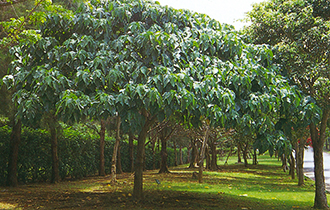
- Macaranga tanarius (parasol leaf tree) (Euphorbiaceae)
Ōbagi (lit. large leaf tree), the Japanese name for this tree, comes from the fact that it has large leaves. In Okinawa, it grows naturally in groves in limestone areas. Standing between 3 meters to 5 meters in height, the tree branches spread horizontally in an umbrella-like shape, serving as an excellent shade tree. Its large, wide leaves have been used for wrapping food. Common Okinawan names include chibitakamayaa-gasa and tappiyagii.
-
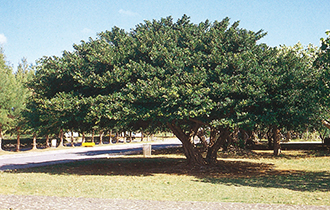
- Banyan tree (Moraceae)
This tree can grow into a very large tree, standing as high as 20 m in height. With aerial roots dropping from its trunk and branches as well as forming brace roots, it can parasitize other plants and kill them. In Okinawa, this tree grows on lowlands, the face of a rocky cliff, on top of trees, etc. on various islands. The fact that when it becomes a large old tree, its unique shape gives it a mysterious and bizarre appearance depending on where it grows, and consequently, it can become a divine or spiritual tree. The roots of this tree are used for medicinal purposes.
-
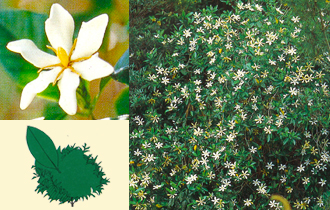
- Common gardenia (Rubiaceae)
This plant can grow to a height of 1 meter to 5 meters, and its leaves are shiny on the surface. Shaped like a pinwheel, its flowers give off a strong aroma. Its fruits become yellowish red as they mature, and they can be used as a dye. In addition, since the fruits also contain a medicinal ingredient, they are used as herbal medicine. The Japanese name (kuchinashi = no mouth) is said to be derived from the fact that dehiscence does not occur in the fruits. The name of this plant in the Okinawan language is “kajimayaa,” which means “pinwheel,” and it comes from the fact that the shape of the flower resembles a pinwheel, as explained above.
-
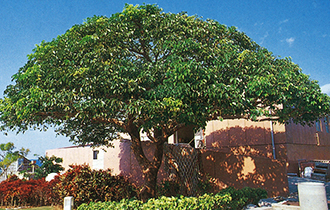
- Bischofia javanica (bishop wood) (Euphorbiaceae)
The Japanese name for this tree is “Akagi” (aka = red, gi (ki) = tree), and the name comes from the red color of the bark and wood. As the wood is dense and hard, it is used for architecture, furniture, handicrafts, etc. The fruit, which has a spherical shape about 1 cm in size, grows in a bunch, and wild birds apparently like to eat them. In Yonaguni Island, it is a food plant for the Yonagunisan (Atlas moth), the largest moth in the world. Since its crown grows wide, this tree is widely used as a roadside tree or a shade tree.
-
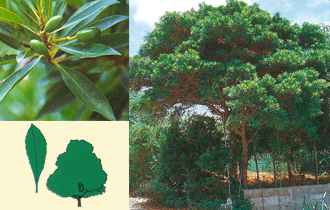
- Elaeocarpus sylvestris (woodland elaeocarpus) (Elaeocarpaceae)
Since the fruit of this tree is similar to the fruit of an olive tree, the woodland elaeocarpus was mistaken for an olive tree during the Edo period, and consequently, it was referred to as the tree of Portugal. Hotoru-no-ki, the Japanese name for this tree, was thus derived from this fact. In Okinawa, these trees grow naturally in low woodland areas. Old leaves turn reddish and fall off the trees. In the old days, this tree was planted in residential premises as a “karii-no-ki,” or a tree that brings good luck, and its branches were placed on the household altar. In the Okinawan language, this tree is known by such names as taarashisaa, taauru, and chindaasaa.
-
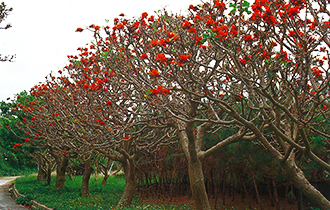
- Deigo (Erythrina variegate) (Leguminosae)
Along with Caesalpinia pulcherrima (peacock flower) and Ixora chinensis (Chinese Ixora), the flower of this tree is among the three great flowers of Okinawa, and at the same time, it has also been designated as the prefectural flower. This tree is also used as a material for Ryukyuan lacquerware. In addition to being planted on the roadside and in parks, schools, etc., deigo trees are planted in windbreak and flood control forests, as well as in timber forests. In the Okinawa language, this tree is known by such names as akayōra, zufuki, and ringi.
-
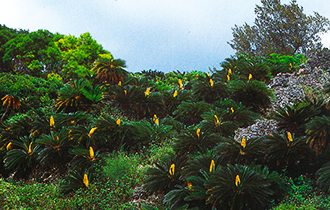
- Cycad (Cycadaceae)
Cycads can be found growing naturally in large numbers in the coasts and lowland wilderness, particularly in limestone areas, on various islands of Okinawa. The trunk of the cycad is dark brown in appearance on the surface and looks solid, but the interior of the trunk is soft. In Okinawa, it is a plant that has been closely related to everyday life from ancient times, with its fruits and stems used as emergency food, live leaves as green fertilizer, and dead leaves as fuel. Cycads are dioecious.
-
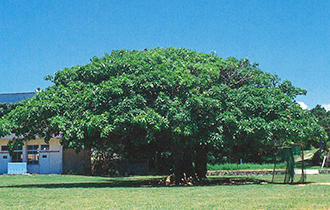
- Ficus superba (sea fig) (Moraceae)
The leaves of this tree fall off irregularly twice a year. The tree has many branches, and it sends out many aerial roots. Its fruits are spherical and turn white from pink as they ripen. When it grows into a large tree, its roots start to appear on the surface of the ground. This species is also known as an epiphytic plant and may strangle parasitic plants. In the Okinawan language, it is called “usukugajumaru” (gajumaru (banyan tree) that grows on stone walls) because it if often found clinging and growing on rocks and stone walls.
-
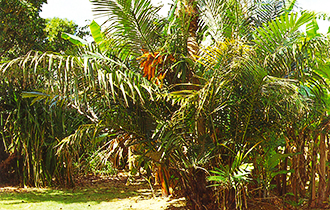
- Arenga engleri (dwarf sugar palm) (Arecaceae)
This tree can be seen from lowlands of limestone areas to the foothills of a mountain. Its flowers have a strong fragrance. The leaf sheath is covered densely with black fiber, and as a hemp palm, it is used as a rope for bundling, a broom, etc. The fruit is about 2 cm in diameter and ripens to a reddish orange color. In the Okinawan language, this tree is known by such names as maani and manin.
© Shurijo Castle Park All Rights Reserved.









